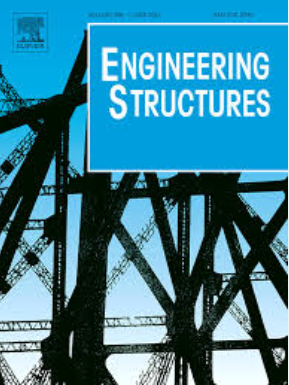GFRP/钢筋加双螺旋箍筋桥墩抗震性能研究
IF 6.4
1区 工程技术
Q1 ENGINEERING, CIVIL
引用次数: 0
摘要
传统的混合配筋桥墩存在地震剪切破坏和钢筋腐蚀等问题。为解决这些问题,提出了一种采用GFRP/钢筋加双螺旋箍筋的抗腐蚀桥墩结构。对8个桥墩在水平准静态往复荷载作用下进行了试验比较。研究了配筋配置、螺旋芯直径、芯纵筋直径和剪跨比等参数对桥墩抗震性能的影响。试验结果表明,所有试件均发生弯曲破坏。双螺旋箍筋的配置为混凝土提供了多重约束,提高了桥墩的承载和耗能能力,避免了桥墩的剪切破坏。同时,由于外层钢筋被GFRP筋代替,防止了钢筋的腐蚀。混合配筋桥墩的峰值荷载略小于钢配筋桥墩,但其延性、极限位移和塑性铰长度均有显著提高。通过有限元模型进行参数分析,确定螺旋芯直径、芯纵筋直径、混凝土强度和外玻璃钢纵筋直径对桥墩峰值荷载的影响。结果表明,增大桥墩内外纵杆直径和螺旋芯直径可以有效提高桥墩的结构刚度和承载力。研究结果可为海上地震作用下桥梁下部结构的安全设计提供参考。本文章由计算机程序翻译,如有差异,请以英文原文为准。
Seismic performance of piers reinforced with GFRP/steel bars and double spiral stirrups
Conventional hybrid-reinforced piers have unresolved issues of seismic-induced shear failure and steel bar corrosion. To solve these problems, a corrosion-resist pier structure reinforced with GFRP/steel bars and double spiral stirrups is proposed. Eight piers were tested and compared under horizontal quasi-static reciprocating loading. The influence of parameters on the seismic performance of the piers was investigated, including the reinforcement configuration, spiral core diameter, core longitudinal bar diameter and shear span ratio. The test results show that all the specimens had a flexural failure. The double spiral stirrups configuration provides multiple confinements on concrete, improves the bearing and energy dissipation capacity of piers, and avoids the shear failure in piers. At the same time, corrosion of steel bars is prevented because the outer steel bars are replaced by GFRP bars. While the peak loads of the hybrid-reinforced piers were a little smaller than those of the steel-reinforced piers, their ductility, ultimate displacement and plastic hinge length improved significantly. A parameter analysis of finite element models was made to determine the influence of the spiral core diameter, core longitudinal bar diameter, concrete strength and outer GFRP longitudinal bar diameter on the peak load of the piers. The results show that increasing the outer and interior longitudinal bar diameters and spiral core diameter can improve the structural stiffness and bearing capacity of the piers effectively. This study provides reference for the safety design of bridge substructures under offshore earthquake actions.
求助全文
通过发布文献求助,成功后即可免费获取论文全文。
去求助
来源期刊

Engineering Structures
工程技术-工程:土木
CiteScore
10.20
自引率
14.50%
发文量
1385
审稿时长
67 days
期刊介绍:
Engineering Structures provides a forum for a broad blend of scientific and technical papers to reflect the evolving needs of the structural engineering and structural mechanics communities. Particularly welcome are contributions dealing with applications of structural engineering and mechanics principles in all areas of technology. The journal aspires to a broad and integrated coverage of the effects of dynamic loadings and of the modelling techniques whereby the structural response to these loadings may be computed.
The scope of Engineering Structures encompasses, but is not restricted to, the following areas: infrastructure engineering; earthquake engineering; structure-fluid-soil interaction; wind engineering; fire engineering; blast engineering; structural reliability/stability; life assessment/integrity; structural health monitoring; multi-hazard engineering; structural dynamics; optimization; expert systems; experimental modelling; performance-based design; multiscale analysis; value engineering.
Topics of interest include: tall buildings; innovative structures; environmentally responsive structures; bridges; stadiums; commercial and public buildings; transmission towers; television and telecommunication masts; foldable structures; cooling towers; plates and shells; suspension structures; protective structures; smart structures; nuclear reactors; dams; pressure vessels; pipelines; tunnels.
Engineering Structures also publishes review articles, short communications and discussions, book reviews, and a diary on international events related to any aspect of structural engineering.
 求助内容:
求助内容: 应助结果提醒方式:
应助结果提醒方式:


